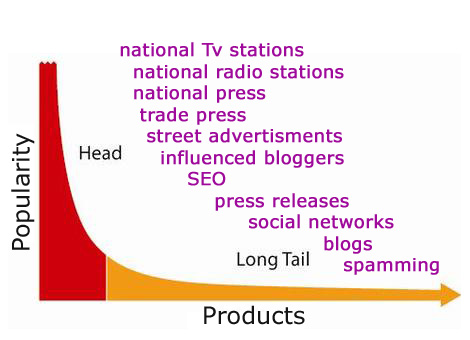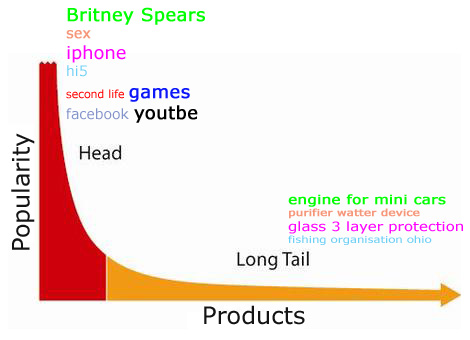 The phrase The Long Tail was invented by Chris Anderson in an Wired magazine article to describe the niche strategy of businesses, such as Amazon or Netflix, that sell a large number of unique items in relatively small quantities. As an example, Amazon makes 57% of sales from keywords outside of the popular terms. This article lead to a book named “The Long Tail” which was released in a new version this week, with a new cover and a lower price.
The phrase The Long Tail was invented by Chris Anderson in an Wired magazine article to describe the niche strategy of businesses, such as Amazon or Netflix, that sell a large number of unique items in relatively small quantities. As an example, Amazon makes 57% of sales from keywords outside of the popular terms. This article lead to a book named “The Long Tail” which was released in a new version this week, with a new cover and a lower price.
The Long Tail is the phenomenon that the sum of less frequent searches is greater than the sum of the top searches. The tail are the niche products, individually unimportant, but collectively significant.
One example of this is the theory’s prediction that demand for products not available in traditional bricks and mortar stores is potentially as big as for those that are. But the same is true for video not available on broadcast TV on any given day, and songs not played on radio. In other words, the potential aggregate size of the many small markets in goods that don’t individually sell well enough for traditional retail and broadcast distribution may someday rival that of the existing large market in goods that do cross that economic bar.
Long Tails everywhere?
The Long Tail is one of those business books that, ironically, deserves more than a niche readership. Anderson encourage others to see Long Tails everywhere, so my vision of “Long Tail of Searches” and “Long Tail of Online Marketing” is illustrated in the bellow charts.


Listen to the podcast with Chris Anderson talking about the ideas in his new book, The Long Tail: Why the Future of Business is Selling Less of More.

Bought this book – very usefull to newbies of SEO and experts.